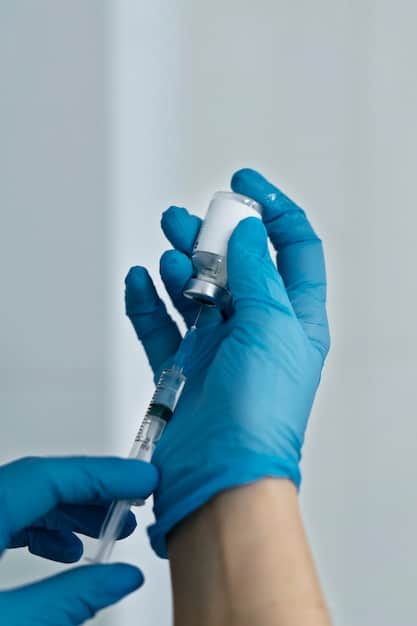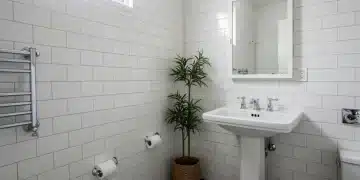Non-Surgical Rhinoplasty: Straighten Your Nose with Dermal Fillers

Non-surgical rhinoplasty, also known as a liquid nose job, utilizes dermal fillers to correct nasal imperfections, providing a straighter, more defined nose in under 30 minutes without invasive surgery, offering a temporary yet effective aesthetic enhancement.
In the evolving landscape of cosmetic enhancements, the desire for quick, effective, and minimally invasive procedures has led to remarkable innovations. Among these, Non-Surgical Rhinoplasty: Achieve a Straighter Nose in Under 30 Minutes with Dermal Fillers stands out as a groundbreaking solution. This approach offers a compelling alternative to traditional surgery, providing a refined nasal contour with impressive speed and minimal downtime. For those in the US considering a subtle yet significant change to their appearance, understanding this procedure is key.
Understanding Non-Surgical Rhinoplasty
Non-surgical rhinoplasty, often referred to as a “liquid nose job,” is a cosmetic procedure that uses injectable dermal fillers to modify the shape of the nose without the need for traditional surgery. Unlike surgical rhinoplasty, which involves reshaping bone and cartilage, this non-invasive technique focuses on adding volume strategically to smooth out bumps, lift the tip, or correct asymmetry. The process is remarkably quick, typically completed within 15 to 30 minutes, earning it the moniker “lunchtime nose job.”
The appeal of non-surgical rhinoplasty lies in its immediate results and minimal recovery period. Patients can often return to their daily activities almost immediately after the procedure. This stands in stark contrast to surgical options, which require weeks or even months of healing. The temporary nature of dermal fillers also provides an advantage for individuals who are not ready for a permanent change or wish to “test drive” a new nose shape before committing to surgery.
What are Dermal Fillers?
Dermal fillers are gel-like substances injected beneath the skin to restore lost volume, smooth lines, and enhance facial contours. In the context of non-surgical rhinoplasty, commonly used fillers are composed of hyaluronic acid (HA), a naturally occurring substance in the body. HA fillers like Juvéderm, Restylane, and Voluma are preferred due to their safety profile, reversibility, and ability to be meticulously molded for precise results.
- Hyaluronic Acid: A natural substance, found in the body, aids in maintaining skin hydration and volume.
- Temporary Effects: Results typically last between 6 to 18 months, depending on the filler type and individual metabolism.
- Reversibility: HA fillers can be dissolved with an enzyme called hyaluronidase, offering an added layer of safety and peace of mind.
The choice of filler is critical and is determined by the specific aesthetic goals and the practitioner’s expertise. Thicker, more viscous fillers are often used for structural support and to create sharper lines, while softer fillers might be employed for subtle enhancements. A thorough consultation with a qualified medical professional is essential to determine the most suitable filler and approach for each individual case.
The procedure itself involves a series of small injections, usually after a topical anesthetic has been applied to minimize discomfort. The practitioner carefully injects the filler into specific areas of the nose to achieve the desired refinement. This precision requires a deep understanding of nasal anatomy and an artistic eye to create a balanced and harmonious result that complements the patient’s overall facial features. The immediate visibility of results allows for real-time adjustments, providing an interactive and personalized experience.

The Procedure: What to Expect in Under 30 Minutes
The promise of achieving a straighter nose in under 30 minutes is a significant draw for many considering non-surgical rhinoplasty. The procedure’s efficiency does not compromise its precision; instead, it is a testament to advancements in aesthetic medicine and the skill of experienced practitioners. Understanding the step-by-step process can alleviate anxieties and set realistic expectations for anyone interested in this treatment.
Before the actual injections begin, a comprehensive consultation is paramount. This initial meeting allows the patient to discuss their aesthetic goals, concerns, and medical history with the practitioner. The practitioner will assess the nasal structure, skin quality, and overall facial symmetry to determine if non-surgical rhinoplasty is the best option. Realistic outcomes are discussed, and a personalized treatment plan is formulated. This collaborative approach ensures that both the patient and the practitioner are aligned on the desired results.
Step-by-Step Experience
Once the treatment plan is finalized, the procedure typically unfolds as follows:
- Preparation: The area of the nose to be treated is thoroughly cleansed, and a topical numbing cream is applied to minimize discomfort during the injections. Some fillers also contain lidocaine, a local anesthetic, further enhancing comfort.
- Injection: Using a fine needle or a blunt-tipped cannula, the dermal filler is meticulously injected into specific areas of the nose. This might include the bridge to smooth out a dorsal hump, the tip to lift or refine its shape, or the side walls to correct asymmetry.
- Molding: Immediately after injection, the practitioner gently molds and sculpts the filler to achieve the desired shape. This real-time adjustment is a crucial advantage of non-surgical rhinoplasty, allowing for precise control over the final outcome.
- Assessment: The patient is given a mirror to review the results, and further minor adjustments can be made if necessary. This interactive component ensures patient satisfaction.
- Post-Procedure Care: After the desired shape is achieved, the area is cleaned again, and post-care instructions are provided.
The entire injection process, from numbing to final assessment, typically takes between 15 to 30 minutes. The speed of the procedure makes it easily fit into a busy schedule, living up to its “lunchtime” reputation. Patients often report minimal pain, usually feeling only a slight pressure or a brief stinging sensation during injections. The swiftness of the treatment, combined with immediate visible results, contributes significantly to its growing popularity.
Following the procedure, patients may experience some mild swelling, redness, or bruising at the injection sites. These side effects are generally temporary and subside within a few days. Specific aftercare instructions, such as avoiding strenuous exercise, excessive heat exposure, and certain medications, are usually provided to optimize healing and ensure the longevity of results. The convenience and efficacy of this procedure make it a highly attractive option for those seeking a quick and significant improvement to their nasal aesthetics.
Who is a Candidate for Non-Surgical Rhinoplasty?
While non-surgical rhinoplasty offers a compelling alternative to traditional surgery, it is not suitable for everyone. Identifying the ideal candidate involves understanding both the capabilities and limitations of dermal fillers. This procedure excels at adding volume and smoothing contours, making it particularly effective for certain types of nasal imperfections rather than reducing overall size or correcting major structural issues.
An initial consultation with a qualified and experienced practitioner is crucial to determine suitability. During this consultation, the practitioner will assess the patient’s nasal anatomy, medical history, and aesthetic goals. It’s important for patients to have realistic expectations and a clear understanding of what can be achieved with fillers. Non-surgical rhinoplasty is about refinement and enhancement, not a complete overhaul.
Ideal Candidate Characteristics
The best candidates for non-surgical rhinoplasty typically share several common characteristics and aesthetic goals:
- Dorsal Hump Correction: Individuals with a prominent bump on the bridge of their nose can benefit greatly. Fillers can be strategically placed above and below the hump to create a smoother, straighter profile.
- Nasal Tip Refinement: For those with a drooping or undefined nasal tip, fillers can be used to lift and project the tip, making it appear more refined and symmetrical.
- Asymmetry Correction: Minor asymmetries in the nasal bridge or tip can be softened and balanced with carefully placed injections, creating a more harmonious appearance.
- Post-Surgical Revisions: Patients who have undergone surgical rhinoplasty but have residual minor irregularities or need subtle adjustments can often find solutions with non-surgical techniques.
- Non-Permanent Solution Seekers: Individuals who are uncertain about committing to permanent surgical changes or prefer a reversible option are ideal candidates for non-surgical methods.
- Good General Health: Candidates should be in good overall health, without active skin infections, allergies to filler components, or certain autoimmune conditions.
It’s important to note that non-surgical rhinoplasty cannot address all nasal concerns. It is not effective for significantly reducing the overall size of the nose, narrowing a wide nose, or correcting major breathing issues. These types of concerns typically require surgical intervention. Furthermore, individuals with very thin skin over their nose might not be ideal candidates, as fillers could potentially be more visible or prone to complications.
The decision to pursue non-surgical rhinoplasty should be made after careful consideration and a thorough discussion with a board-certified dermatologist, plastic surgeon, or other qualified aesthetic physician. The expertise of the injector is paramount in achieving safe, natural-looking, and satisfying results. Choosing a practitioner with extensive experience in facial anatomy and advanced injection techniques is crucial for optimizing outcomes and minimizing risks.
Benefits and Advantages of Dermal Fillers for Nose Reshaping
The surging popularity of non-surgical rhinoplasty can be largely attributed to its numerous benefits and distinct advantages over traditional surgical methods. For those seeking aesthetic improvements to their nose, dermal fillers offer a compelling blend of convenience, safety, and effectiveness. These benefits extend beyond just the immediate physical transformation, encompassing psychological and practical advantages.
One of the foremost advantages is the speed and minimal invasiveness of the procedure. As the name suggests, achieving a straighter nose can be done in under 30 minutes, a stark contrast to the hours-long commitment of surgical rhinoplasty. This quick turnaround time, coupled with the absence of general anesthesia, significantly reduces the risks and recovery period associated with surgery. Patients can often resume their normal activities almost immediately, making it an ideal “lunchtime” procedure for busy individuals.
Key Advantages
The use of dermal fillers for nose reshaping presents several compelling benefits:
- Non-Surgical: Eliminates the need for incisions, general anesthesia, and bone/cartilage manipulation, reducing surgical risks and complications.
- Immediate Results: The aesthetic improvements are visible almost instantly, allowing patients to see the transformation immediately after the procedure.
- Minimal Downtime: While some swelling or bruising may occur, most patients can return to work and daily activities within a day or two, unlike the weeks of recovery required for surgery.
- Reversibility: Hyaluronic acid fillers, which are commonly used, can be dissolved with hyaluronidase if the patient is dissatisfied with the results or experiences complications, offering a safety net.
- Temporary Nature: Ideal for individuals who are not ready for a permanent change or wish to “test drive” a new nose shape. Results typically last 6-18 months.
- Cost-Effective: Generally more affordable than surgical rhinoplasty, making aesthetic nose enhancement accessible to a broader range of individuals.
- Precision and Customization: The ability to sculpt and mold the filler in real-time allows for highly personalized and precise adjustments, achieving nuanced improvements.
Beyond the practical advantages, the psychological benefits are also significant. The temporary nature of fillers allows patients to experiment with their appearance without the lifelong commitment of surgery. This can be particularly reassuring for those who are hesitant or uncertain about undergoing a permanent alteration. The lower risk profile and reduced recovery time also contribute to a less stressful experience overall.
Furthermore, non-surgical rhinoplasty offers an opportunity for subtle enhancements that contribute to overall facial harmony. It’s not about creating a drastically different nose but rather refining existing features to create a more balanced and aesthetically pleasing profile. This focus on natural-looking results is highly appealing to a demographic that values understated beauty and a refreshed appearance rather than an obviously “done” look. The ability to correct minor imperfections with such ease and efficiency makes it a valuable tool in modern aesthetic medicine.
Potential Risks, Side Effects, and Important Considerations
While non-surgical rhinoplasty is celebrated for its minimal invasiveness and quick results, it is crucial to approach the procedure with a full understanding of its potential risks, side effects, and important considerations. No cosmetic treatment is entirely without risk, and dermal filler injections, especially in a delicate area like the nose, require significant expertise and careful planning to ensure patient safety and optimal outcomes.
The nasal area is richly supplied with blood vessels, including those connected to the eye. Incorrect injection techniques or accidental injection into a blood vessel can lead to serious complications, such as vascular occlusion, skin necrosis (tissue death), or even blindness. This underscores the paramount importance of choosing a highly experienced and board-certified practitioner who possesses in-depth knowledge of facial anatomy and advanced injection methods. Patient safety should always be the top priority.
Common Side Effects and Rare Complications
Patients should be aware of both transient side effects and the potential for more serious, albeit rare, complications:
- Common Side Effects (Temporary):
- Swelling
- Redness
- Bruising
- Tenderness or mild discomfort at the injection site
- Initial unevenness (which usually resolves as swelling subsides)
- Rare Complications (Serious):
- Vascular Occlusion: Blockage of a blood vessel leading to tissue death (necrosis).
- Infection: Though rare, any break in the skin can introduce bacteria.
- Allergic Reaction: Though uncommon with HA fillers, possible in sensitive individuals.
- Lumps or Nodules: Can sometimes form, though often treatable.
- Blindness: Extremely rare but possible if filler is injected into blood vessels connected to the eye.
To minimize risks, several crucial steps should be taken. Always select a reputable clinic and a qualified medical professional with significant experience specifically in non-surgical rhinoplasty. During the consultation, be completely transparent about your medical history, including any allergies, medications (especially blood thinners), and previous cosmetic procedures. Following all pre- and post-procedure instructions diligently is also vital for a safe recovery.
It’s also important to have realistic expectations. Non-surgical rhinoplasty is excellent for subtle refinements and corrections, but it cannot fundamentally alter the underlying bone or cartilage structure. Patients seeking dramatic reductions in nasal size or significant structural changes might be better suited for surgical options. A thorough discussion with your practitioner about what is achievable and what limitations exist will help manage expectations and ensure satisfaction with the outcome. Always prioritize safety and informed decision-making when considering any cosmetic procedure.
Maintaining Your Results: Longevity and Follow-Up
Once you’ve achieved your desired nasal aesthetic through non-surgical rhinoplasty, the next natural question is about the longevity of the results and what steps are needed for maintenance. Understanding how dermal fillers behave over time and the importance of follow-up treatments is crucial for preserving your refined nose shape and ensuring sustained satisfaction with the procedure.
The temporary nature of dermal fillers is both a benefit and a consideration. While it allows for reversibility and adjustment, it also means that the results are not permanent. The body naturally metabolizes hyaluronic acid over time, gradually diminishing the effects of the filler. The duration of results can vary significantly among individuals, influenced by factors such as the type of filler used, the patient’s metabolism, and the specific area treated.
Factors Influencing Longevity
Several factors play a role in how long the results of non-surgical rhinoplasty will last:
- Type of Filler: Different hyaluronic acid fillers have varying degrees of cross-linking and viscosity, which affects their degradation rate. Thicker, more robust fillers generally last longer.
- Individual Metabolism: People metabolize fillers at different rates. Those with faster metabolisms may find their results diminish more quickly.
- Injection Area: The nose is a less मोबाइल (mobile) area compared to lips or cheeks, which can contribute to slightly longer-lasting results than other facial areas.
- Amount of Filler Used: The volume of filler injected can also influence how long the desired effect is maintained.
- Lifestyle Factors: While not as significant as biological factors, general health, hydration, and sun exposure can indirectly influence skin health and filler integrity.
Typically, patients can expect their non-surgical rhinoplasty results to last anywhere from 6 to 18 months. Some advanced fillers are designed to offer results for up to 18-24 months in certain areas. As the filler slowly breaks down, patients will gradually notice a return to their original nasal contours. This gradual change allows for a smooth transition and ample time to schedule a touch-up appointment.
To maintain the results, follow-up or “maintenance” treatments are necessary. These typically involve re-injecting a smaller amount of filler to top up the volume and refine the shape before the original filler has completely dissipated. Scheduling these touch-up sessions strategically can help ensure a continuous and consistent aesthetic appearance. Your practitioner will advise on the optimal timing for these follow-up appointments based on your individual response to the filler and the specific product used.
Regular communication with your aesthetic professional is key to managing expectations and planning for maintenance. They can help you understand the natural progression of filler degradation and recommend the best schedule for follow-up treatments to keep your nose shape looking its best. This personalized approach to care ensures long-term satisfaction and builds a trusting relationship between patient and provider.
Comparing Non-Surgical vs. Surgical Rhinoplasty: Which is Right for You?
The decision to alter the appearance of your nose is a significant one, and exploring both non-surgical and surgical rhinoplasty options is a common part of the journey. Each approach offers distinct benefits and limitations, making the “right” choice highly individual and dependent on personal goals, desired outcome, and tolerance for recovery. Understanding these differences is critical for making an informed decision.
Traditional surgical rhinoplasty has long been the gold standard for comprehensive nasal reshaping. It involves incisions, anesthesia, and the actual manipulation of bone and cartilage to achieve permanent structural changes. This method is ideal for significant alterations, such as reducing overall nose size, narrowing wide nostrils, correcting severe asymmetries, or addressing breathing issues. The results are permanent, but the recovery is extensive, and there are inherent surgical risks.
Surgical vs. Non-Surgical Comparison
Here’s a breakdown of key aspects to consider when weighing your options:
- Invasiveness:
- Surgical: Highly invasive, involves general anesthesia, incisions, and manipulation of bone/cartilage.
- Non-Surgical: Minimally invasive, uses injectable fillers, topical anesthetic, no incisions.
- Results:
- Surgical: Permanent, can achieve dramatic changes in size and structure, addresses functional issues.
- Non-Surgical: Temporary (6-18 months), focuses on subtle refinements, smoothing bumps, lifting tips, correcting minor asymmetries.
- Downtime/Recovery:
- Surgical: Weeks of recovery, significant swelling and bruising, potential for discomfort, limited activity.
- Non-Surgical: Minimal downtime, most can resume activities immediately, mild swelling/bruising for a few days.
- Risks:
- Surgical: Anesthesia risks, infection, scarring, unsatisfactory permanent results, breathing difficulties.
- Non-Surgical: Less severe, but includes bruising, swelling, rare complications like vascular occlusion (can lead to tissue death or blindness if not managed by an expert).
- Cost:
- Surgical: Significantly higher upfront cost, though a one-time expense.
- Non-Surgical: Lower per-session cost, but recurring costs for maintenance treatments over time.
For individuals seeking substantial, permanent changes to their nose, especially those involving significant reduction in size or correction of breathing problems, surgical rhinoplasty remains the most appropriate choice. It offers the ability to completely restructure the nose, providing comprehensive and lasting results. However, this comes with a greater commitment in terms of time, recovery, and financial investment, along with increased surgical risks.
Conversely, non-surgical rhinoplasty is an excellent option for those desiring subtle enhancements, corrections of minor imperfections, or a temporary “test drive” of a new nose shape. It is particularly appealing for correcting dorsal humps, lifting a droopy tip, or smoothing out irregularities with minimal commitment and downtime. Its reversibility also offers peace of mind. Ultimately, the best path forward involves a candid discussion with a skilled practitioner who can assess your specific needs and guide you toward the most suitable and safest option to achieve your aesthetic goals.

The Future of Non-Surgical Nasal Aesthetics
The field of aesthetic medicine is continuously innovating, and non-surgical nasal aesthetics is no exception. As technology and techniques advance, we can anticipate even more sophisticated and precise treatments, further solidifying the role of non-surgical rhinoplasty as a cornerstone of facial harmonization. The future promises enhanced safety, improved longevity, and expanded applications for non-invasive nose reshaping.
One primary area of development is in the evolution of dermal fillers themselves. Researchers are constantly working on new generations of fillers that offer improved biocompatibility, greater longevity, and enhanced rheological properties. This means fillers that integrate more seamlessly with tissue, last longer without compromising safety, and can be molded with even greater precision. Such advancements will allow practitioners to achieve more refined and natural-looking results, tailored exactly to each patient’s unique anatomy and desires.
Anticipated Advancements
Several exciting developments are on the horizon for non-surgical nasal aesthetics:
- New Filler Formulations: Expect materials that offer extended duration, better tissue integration, and reduced risk of complications.
- Advanced Injection Techniques: Continued refinement of techniques, including the increased use of cannulas over needles to minimize bruising and vascular risk.
- Combination Therapies: Integration of fillers with other non-invasive technologies, such as thread lifts or energy-based devices, to achieve a more comprehensive result.
- 3D Imaging and AI-driven Planning: Utilization of advanced imaging and artificial intelligence to meticulously plan treatments, predict outcomes, and ensure unprecedented precision.
- Bio-Stimulatory Fillers: The development of fillers that not only add volume but also stimulate the body’s natural collagen production, potentially leading to longer-lasting and more natural results.
The role of technology in pre-procedure planning and post-procedure assessment is also expanding. Innovations like 3D imaging and artificial intelligence (AI) are beginning to play a more significant role. AI-driven platforms can analyze facial features, suggest optimal injection points, and even simulate potential outcomes, allowing patients to visualize their results before any injections are made. This level of personalized planning will undoubtedly enhance patient satisfaction and reduce the likelihood of unmet expectations.
Furthermore, there is a growing emphasis on combination therapies. Practitioners are exploring ways to integrate non-surgical rhinoplasty with other minimally invasive treatments, such as PDO thread lifts for additional structural support or certain energy-based devices for skin tightening around the nose. These synergistic approaches could offer more comprehensive improvements to nasal aesthetics and overall facial balance without resorting to surgery.
As the demand for personalized and discreet cosmetic enhancements grows, non-surgical rhinoplasty is poised to remain at the forefront. The ongoing research and development in this field promise not only safer and more effective treatments but also a greater capacity for achieving truly bespoke and aesthetically pleasing results, further empowering individuals to enhance their natural beauty with confidence and ease.
| Key Point | Brief Description |
|---|---|
| ✨ Quick Results | Achieve a straighter nose in under 30 minutes. |
| 💉 Non-Surgical | No incisions, anesthesia, or extensive downtime. |
| 🗓️ Temporary Effect | Effects last 6-18 months; reversible if desired. |
| 🎯 Precision | Corrects bumps, lifts tips, and refines symmetry. |
Frequently Asked Questions About Non-Surgical Rhinoplasty
The results of non-surgical rhinoplasty using hyaluronic acid fillers generally last between 6 to 18 months. The duration can vary based on the specific type of filler used, individual metabolism, and the area treated. Regular touch-up appointments can help maintain the desired aesthetic over an extended period.
Most patients report minimal discomfort during non-surgical rhinoplasty. A topical numbing cream is applied before the procedure, and many dermal fillers also contain lidocaine, a local anesthetic, to enhance comfort. Patients typically describe feeling a slight pressure or brief stinging sensation during the injections.
One of the significant advantages of a liquid nose job is the minimal downtime. Most individuals can return to their normal daily activities immediately after the procedure. Some mild swelling, redness, or bruising at the injection sites may occur, but these side effects are usually temporary and subside within a few days.
Non-surgical rhinoplasty is highly effective for correcting minor to moderate imperfections, such as dorsal humps, drooping tips, and slight asymmetries. However, it is not suitable for fixing severely crooked noses, significantly reducing overall nasal size, or addressing major breathing difficulties. These more complex issues often require traditional surgical rhinoplasty.
While generally safe, potential risks include common side effects like swelling, bruising, and redness. More serious, though rare, complications can include vascular occlusion (blockage of a blood vessel), infection, allergic reactions, or tissue necrosis. Choosing an experienced, board-certified practitioner is crucial to minimize these risks.
Conclusion
Non-surgical rhinoplasty offers a compelling and sophisticated solution for individuals seeking to subtly enhance their nasal aesthetics without the commitment and downtime associated with traditional surgery. With the ability to achieve a straighter, more refined nose in under 30 minutes, this procedure provides immediate, reversible results, making it an attractive option for a broad range of aesthetic goals. As with any cosmetic intervention, careful consideration, realistic expectations, and the selection of an experienced, qualified practitioner are paramount to ensuring both safety and satisfaction with your beautiful, non-surgically enhanced nose. The continued evolution of dermal fillers and injection techniques promises an even brighter future for this innovative approach to facial harmonization.





